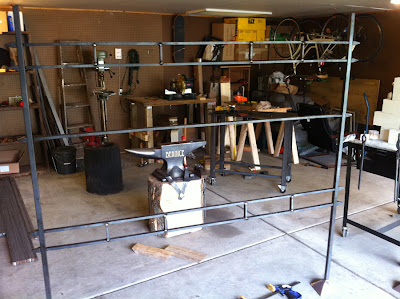 |
| Diamond Rings by Leslie Shershow (plastic). Photo courtesy the artist. |
 |
| Leslie Shershow. Diamond Ring, 2011. Copper, brass, silver, auto paint. Photo courtesy the artist. |
Tell us a little bit about your work.
Right now I'm inspired by wonky home improvements and functional crafts. I find much beauty in the way a novice craftsman might fix his home--I'm interested in the evolution of a domestic structure due to regular maintenance. I tend to work the same way--by starting with an object and scrounging for the part that will turn it into a functional piece of jewelry. The theme is pretty nostalgic for me--I grew up in Maine, so I use fishing and nautical imagery, along with funny home-maintenance things my dad used to do.
I had first learned a little metalsmithing in high school crafts class and hated it. I melted my first project! Later, in college, when it was time to choose my major, I was really impressed by the work that came out of the metals department, so metals is what I chose.
Where do your ideas come from?
Everything, really. I guess my work comes out of interests that keep surfacing over and over again.
 |
| Leslie Shershow's necklace from the Home Improvement Series. Photo courtesy the artist. |
 |
| Leslie Shershow's bracelet from the Home Improvement Series. Photo courtesy the artist. |
What artist or designer do you admire, and why?
Iris Bodemer is one of my favorite jewelers (among many). I admire her because, in a lecture, she told us she took out a bank loan in the form of a gold block and proceeded to slice it into jewelry. That is very admirable to me.
In your bio, it says that you’ve taught metalsmithing to both children and adults. What do you enjoy most about teaching? What is it like teaching metalsmithing to children?
I really enjoy the challenge. Metalsmithing embodies so many different techniques, and many times, there are multiple ways to do something. I mostly taught small classes, so I had to work with each student individually to see what methods work best. Teaching children can be really difficult. Metalsmithing is a tedious and time consuming practice, and there isn't much instant satisfaction. It's hard for kids to sit down and sand for hours, especially when they're wound up from a day at school and candy they got from 7-11.
What are you doing when you’re not creating?
I like hanging out with the other lovely AIRs and HCCC staff, visiting museums, and going for runs. Lately, my boyfriend and I have been working on a large stained-glass terrarium to prevent our cats from eating our plants.
 |
| Metalsmith and jeweler, Leslie Shershow. Photo courtesy the artist. |
Describe yourself in five words.
I like to make things.
Being a Northerner, is there anything you find humorous or strange about Houston? I think it's funny that a lot of people in Houston's public places are either really dressed up or in their gym clothes. I come from a place of in-betweeners.









































